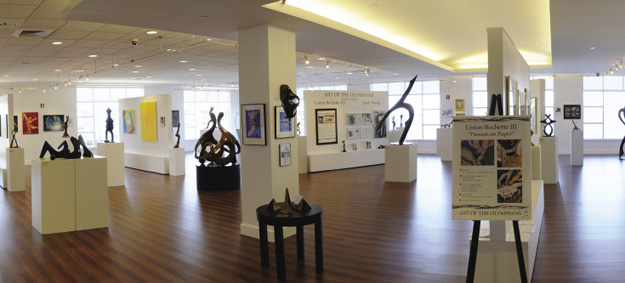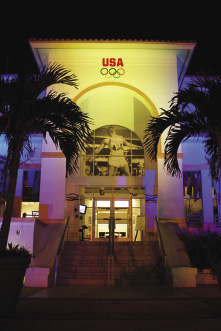


![]()
ONLINE
The Other Side of Olympians
Editors’ Note
Bob Beamon is an American and Olympic track and field gold medalist, best known for his World and Olympic records in the long jump at the Mexico City Olympic Games in 1968. The world record stood for 22 years. The Olympic record continues to stand after nearly 45 years of being unblemished. Shortly after the Mexico City Olympics, Beamon was drafted by the Phoenix Suns basketball team. In 1972, he graduated from Adelphi University with a degree in sociology. Beamon has worked in a variety of roles to promote youth athleticism, including collaborating with former California governor Arnold Schwarzenegger.
Frank K. Wheaton graduated from California State University at Northridge with a degree in Radio/TV and Film. Wheaton worked at several radio stations in Los Angeles as an announcer and producer, and also worked for NBC for several years as an engineer in Washington, D.C. In 1978, Wheaton moved to New York and became one of the top commercial and print actors in America as well as having a role in the television series CounterAttack: Crime in America starring George Kennedy. After the ABC television series ended, Wheaton matriculated at the University of West Los Angeles School of Law and graduated with a degree of Juris Doctor. Currently, the State Bar of Indiana, the United States District Courts in both the Northern and Southern Districts of Indiana, and the United States Court of Appeals, Fifth Circuit all license him. Wheaton has served as an Of Counsel member to several prestigious California law firms. As a professor, Wheaton has taught entertainment law in several law schools and universities. As a television producer, he created the first Michael Jordan Celebrity Golf Classic, World’s Fastest Athlete for ABC’s Wide World of Sports, and Sports Greats: One on One with David Hartman for ESPN, among others.
Organization Brief
Founded by the late USA Olympic discus thrower Al Oerter, Art of the Olympians (www.artoftheolympians.org; AOTO) is a global learning center that brings together Olympic athletes to promote the highest ideals of humanity. Through their creative talents, AOTO is able to provide programs of art, education, sport, and cultural outreach to showcase the sport/art relationship and to inspire the world. The AOTO Museum and Gallery at the Al Oerter Center is a 501(c)(3) nonprofit organization home to unique exhibitions of Olympian art, Olympic memorabilia, and educational activities. The Museum and Gallery opened its doors in January 2010 with great notoriety and later secured the rights to display the USA Olympic Rings – an act protected by Congress.
What is the key mission for Art of the Olympians?
Beamon: The creator is four-time Olympian Al Oerter. I became his teammate in 1968 in Mexico City.
Al had a dream that the Olympics was a two-part event: one was the cultural and the other was the competitive. The cultural has lost its power and today, it’s all competition driven.
The cultural part of it deals with people, places, and things. He felt that the cultural part was as significant as the competitive part, because you did at one point win awards in that too. He wanted that to become part of a new dream he had.

One of the galleries of the 17,000-square-foot Art of Olympians
Museum and Exhibit Hall in Ft. Myers, Florida
He created Art of the Olympians, which was artwork designed and created by Olympic artists only. This is the only facility in the world that carries the five rings other than the Olympic sites.
It was a blessing that he had the vision that would bring athletes to the table who had competed in the Olympics and might not have won, but have another side to their stories.
Art of the Olympians is a 17,000-square-foot exhibit hall and museum that showcases the artwork of great athletes like Peggy Fleming and Flo Jo. No one would know there was another side to these athletes otherwise.
Is there strong awareness of this cause?
Beamon: We are beginning to branch out now. Art is like the hook. We are really passionate about extending our services to hospitals by making appearances with Olympic athletes – Art of the Olympians recently held the Infinite Scholars program. They actually raised $12.9 million dollars in scholarships for kids who otherwise might not be able to attend college.
We go to hospitals to visit kids that have catastrophic illnesses. Some of the kids may never leave the hospital but still have hope, so we touch them with motivational tools – we work with their parents too.
We also have exhibits of different artists every quarter.
Once these former Olympians contribute their art, do they remain involved?
Beamon: Once they are part of us, we will ask them to make an appearance in New York at a hospital for children. So it’s not just artwork but also what you give back.

The entrance to the
Art of Olympians Museum
and Exhibit Hall
Is the scholarship money you’re giving away primarily from corporate donations?
Wheaton: Funding has to be sought from private donors and investors who have a love for the culture, the art, and the international scope of the important museum work.
Al Oerter wanted to reincorporate art into the Olympics Games, where it had been an integral part until 1936. When he passed away, his widow wanted to pass the baton and she thought of Bob Beamon, who has the longest standing international and Olympic record in the history of the modern Olympic Games.
The Art of the Olympians Museum was born several years ago and with the tremendous gift from the City of Fort Myers in helping us with a beautiful 17,000-square-foot building, Art of the Olympians was born.
Bob Beamon has since reached out and touched important and caring folks all over the world, so we will continue to grow.
How broad can this concept become?
Beamon: We’re now looking at sending a lot of children to college, and towards motivating children in the early stages to be the best they can be. We have athletes who visit schools and colleges and talk about their experiences. If you make the Olympic team, whether you win or not, it took a lot to get there, so people like to hear how you did it.
Frank, what excited you about this opportunity and has it been what you expected?
Wheaton: It has far exceeded my expectations. I have a dream job because with Bob, I have flown at the highest altitudes. I have seen things I would otherwise not have seen and I never take anything for granted. Bob Beamon represents that iconoclastic level, a rarified air that so few ever get a chance to experience. It’s not watching history – it’s being a part of making history and Art of the Olympians gives us a platform on which to operate.•